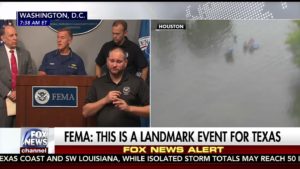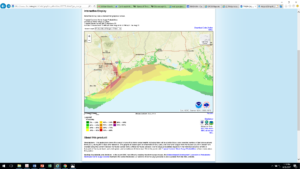NOAA National Weather Service (NWS) Director Dr. Louis Uccellini (leftmost in the screen capture from FOXNEWS Channel’s live broadcast) personally gave a weather forecast update at this morning’s national press conference on Hurricane Harvey.

INNOVIM’s Chief Science Officer, Dr. Philip Ardanuy notes that, “as difficult as conditions are for those caught in the heavy rains and floods in Southeast Texas, it is worth taking a moment to recognize how far our ability to predict the weather a week or more in advance, especially for storms such as these, has advanced in our lifetimes.” Meteorologist Warren Qualley agreed about the huge improvements that have been made over the past few decades. He correctly follows up that “this is as much a social science problem as it is a physical science issue and not one which meteorologists can remedy. I’ve heard that there are some people who fear that their homes will be looted if they evacuate. They’ve made the choice to stay and protect their homes, likely figuring that they can beat the odds against the hurricane’s wind and water. Meteorologists aren’t trained to deal with messaging, although the NWS and others are working toward that. This is very similar to the aftermath of the tornado outbreaks in April and May 2011 (including the ones in Tuscaloosa/Birmingham and in Joplin) which resulted in the Weather-Ready Nation initiative. Yes, there’s still much to do, but I’m confident that the marriage of the two sciences, one physical and the other psychological, will result in fewer lives lost in future weather events.”
A specific outcome of NOAA’s Weather Ready Nation (WRN) initiative has been the integration of social science best practices into the dissemination of weather forecast information to the public through watches, warnings and advisories. INNOVIM directly supports this both as a WRN Ambassador, and through our work under contract to the NWS on the Hazard Simplification (Haz Simp) project. We helped NWS to plan and execute the 2015 HazSimp workshop at NWS Central Region Headquarters, which consisted over 125 attendees from the Private/Public sectors, including emergency managers. The INNOVIM-supported HazSimp Workshop brought together federal and private sector stakeholders (including social scientists) to assess the current NWS hazard messaging system. Feedback from this Workshop led to the development and execution of a Social Science-led Generalizable Survey which tested alternative hazard messaging paradigms. Working with the HazSimp project, we helped to collect, organize, analyze, and document data and information—output from three public survey feedback opportunities. The data from these surveys supported NWS’ decision to consolidate and reformat 20% of its hazard messaging products.

The first changes to the NWS Watch, Warning, and Advisory (WWA) system will be implemented on October 1 based on social science findings from the Haz Simp project. The second set of changes, which will apply to all flood products nationwide, is currently scheduled for late winter/early spring 2018.
INNOVIM is also supporting the NWS National Hurricane Center (NHC’s) Storm Surge Unit for projects contributing to the Inter-Agency National Hurricane Program (NHP). INNOVIM scientist William Booth is processing Sea, Lake, and Overland Surges from Hurricanes (SLOSH) model forecasts for high-resolution inundation mapping, developing improved visualization and automated workflows for mapping real-time guidance, and support the use of NWS/NHC storm surge risk GIS data for NHP and other federal partners. The resultant Potential Storm Surge Flooding Map went operational for the 2016 Hurricane Season. This map displays the potential risk from storm surge flooding from a landfalling tropical cyclone. It supported operations for Tropical Storm Colin, Hurricane Hermine, and Hurricane Matthew, and is currently in operational use for Hurricane, now Tropical Storm, Harvey as illustrated in the Realtime Storm Surge Modeling for Hurricane Harvey image, captured at 1:00pm ET 28 August.
